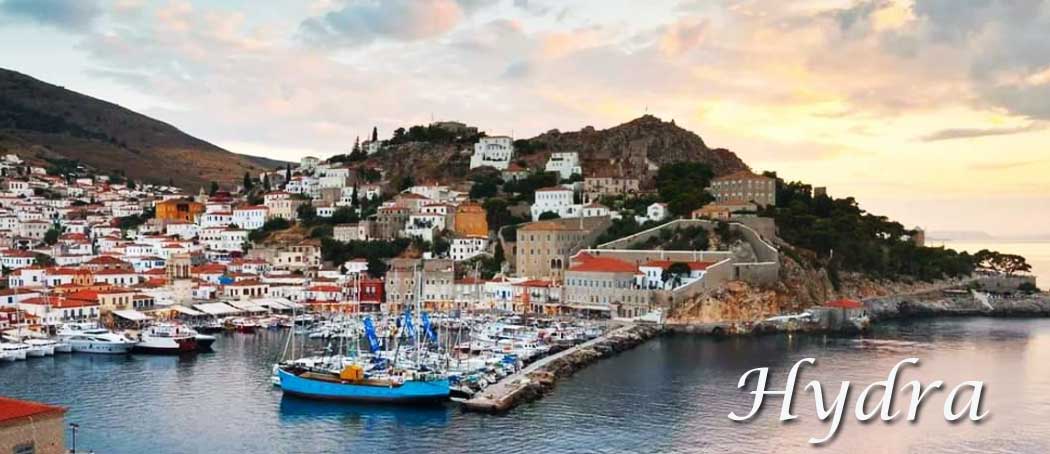Information about Hydra island Greece

Hydra was ‘discovered’ in the 1960s by artists such as the Canadian singer Leonard Cohen and its harbourside cafes have frequently entertained celebrities, ranging from US writer Henry Miller to British rocker Mick Jagger. By the late 1960s, Hydra had already become a haven for celebrities from all over the world. Onassis, Maria Callas, Brigitte Bardot, John Lennon and the Rolling Stones, among others, strolled through the picturesque port and partied at the island’s legendary night clubs.
Freed from car noises, Hydra invites you to stop time and relax, walk its cobbled streets, admire the captain’s houses and well-kept mansions with their simple lines and wander its paths.
Important personalities of letters and the arts, but also famous names of the international jet set fell in love with this rocky island of the Argosaronic with its simple landscapes and put their signature on its legend.
The long, thin island is characterised by its rocky interior, virtually uninhabited with just the odd farmhouse to accompany its few, remote and deserted monasteries.
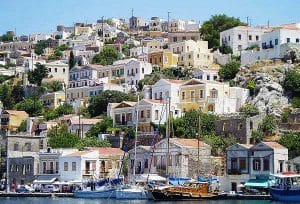
Today, strict building laws protect the island’s traditional architectural styles and help preserve its serene beauty, although some might find the freshly painted walls and doors just a little too twee for good taste,
Donkeys and boats are still the only form of transport as cars and motorbikes are banned.
Hydra may have no notable beaches, and much of its woodland has been lost to forest fires, but it’s still a Greek island that oozes charm while rich Athenians make up a large proportion of its regular visitors. Hydra is a weekend getaway target for wealthy Greek mainlanders and an inviting destination for a relaxed retreat.
The architecture of Hydra is exceptional among the Greek islands. Wealthy merchants built beautiful mansions here. Many of the island’s mansions have been faithfully restored with brightly coloured doors and window shutters.
There are only a few sand beaches on Hydra and these tend to be crowded. The rest are of stone, pebble and rock.
About Hydra
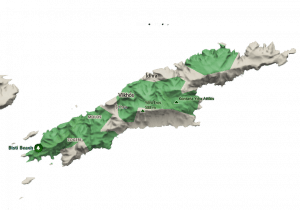
The terrain is rocky and mountainous, the highest peak being Mount Klimaki at 600 metres. It was once dense with forest but many trees were destroyed by fire in 2007 and forests are now confined to the valleys. The name Hydra means ‘water’ and is derived from springs that have long dried up and all water is now imported.
Hydra is elongated with an area of 50 sq km and a coastline of 56 kilometres. The population of around 2,700 and is concentrated in Hydra Town, with tourism and fishing the main industries.
Climate and weather
Hydra lies to the south of the sheltered Argo Saronic Gulf and summers are dry and almost cloud-free from June to August with temperatures at 21-25°C, rising to 28°C in August.
Spring and autumn are considered good times for walking holidays on Hydra as the temperatures and humidity are more comfortable. Winters on Aegina are relatively dry but rain often falls in November. Winters are mild at an average 8°C.
The town of Hydra
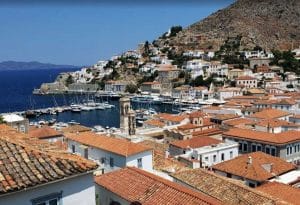
Steep stone streets lead up from the harbour lined with stout grey houses and impressive mansion houses, most of them topped with red tiled roofs.
Once heavily populated by wealthy merchants and shipbuilders, Hydra’s imposing mansions are not seen in such abundance on any other Greek island.
Many homes are tall and narrow, a consequence of steeply rising land, and many have been restored by rich Athenians who opted for bright colours on shutters, doors and walls.
The most populated area is the oldest, Kiafa, which sits high above the port with fine views over the bay. Arched bridges cross some streets to connect the houses and stone windmills at the summit complete the scene.
The Church of the Assumption of the Virgin, in the centre of Hydra Town, has a notable three-storey bell tower made of Tinos marble. Founded as a monastery in 1643, only the church and a few monk cells remain.
Behind the church, the Kountouriotis museum is housed in a former mansion house and has engaging exhibits of Hydra’s maritime heritage. Through the archway under the waterfront clock tower is the Byzantine Museum with its extensive collection of religious artefacts.
Things to do
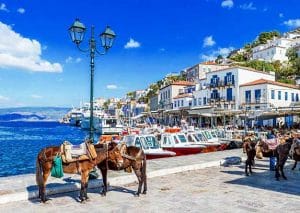
Your attention will be drawn to the mansions of the island’s historic families that rise around the port.
These three- and four-story imposing and at the same time modest buildings bear witness to the economic prosperity and prosperity experienced by the island at the end of the 18th century.
Then climb up to Kiafa, Hydra’s oldest quarter, with its stone-built houses, tall battlements, narrow streets and picturesque churches. At the top of the hill rises the Church of Agios Konstantinos of Hydraios.
From here you can enjoy a fantastic view that reaches all the way to the Peloponnese. Also, a particularly beautiful hike will lead you after about 60 minutes to the monastery of Prophet Ilias, founded in 1813.
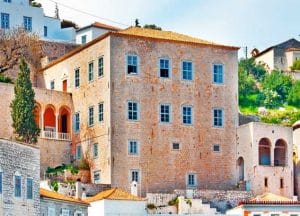
Visit the Historical Archive-Museum of Hydra, on the eastern side of the port, to see great paintings of the 19th century and a number of relics from the 1821 War, Hydra costumes of the time, maps, cannons, wooden promontories and ship masts, etc.
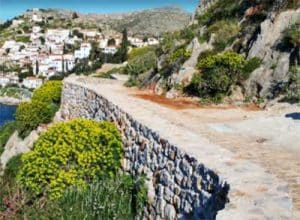
Take a dive from the cliffs of Hydroneta, under the famous cannons. After Hydroneta is Avlaki, a small beach with pebbles.
The connection of the city with the other beaches of the island is made by the sea, by boats or water taxis, but also by foot. You will find organized beaches in Kamini, Vlychos, Plakes, Madraki and Bisti.
During the Easter, old customs linked to the sea are revived on the island of Hydra. One of the most beautiful and picturesque religious customs of Hydra and of all of Greece is the procession of the Epitaph of the parish church of Agios Ioannis the Forerunner in the district of Kaminia by the sea.
What to see
Hydra is οne of the most picturesque and atmospheric islands of the Argosaronic Islands, ideal for romantic and art weekends.
The architectural shell of the once prosperous and historic maritime state of the early 19th century has been preserved intact and within it has been built a sophisticated tourist resort with beautiful guesthouses and timeless meeting points.
The high-rise mansions, some of which can be visited, are impressive. The port is the heart of the island and essentially the only settlement.
Around it and in the back alleys you will find nice cafes and restaurants as well as arty boutiques.
Starting from Chora, you can take various nice walks: the two most classic options are either to the Historical Archive and the Port Authority or to Kiafa with the mansions of the Kountouriotis and from there, along the beaches, to Spilia, Mylos and Kamini.
If you are not good with walking and stairs, it is better to choose another island, as there are no cars and the routes are either on foot or by water taxi.
In addition to the mansions and museums that can be visited, Hydra has a strong artistic movement and every summer a series of contemporary art exhibitions are held here, the most famous of which are organized by Daki Ioannou in the Old Slaughterhouses and Dimitris Antonitsis in the Old Gymnasium.
The churches are also interesting: the Dormition Monastery in the harbor and the churches of Agios Ioannis the Fasting with frescoes from the 18th century and of Agios Constantine the Great made of hewn stone.
Many visitors to Hydra are day-trippers or Athenian weekenders and they tend not to venture much further than the bustling waterfront where the ferries and hydrofoils dock.
If you’re on a flying visit you’ll find more than enough to see and do in Hydra Town but if you plan to stay more than a couple of days take the time to explore the rest of the island with its unspoilt countryside mercifully free of the holiday hordes.
The most striking thing about the port is its array of impressive white and pastel-coloured stone mansions (known as “archontika”) built by wealthy shipowners in the 18th and 19th centuries. They’re definitely worth taking a look at though you’ll be lucky to get a glimpse inside any of them.
The Tombazis mansion, on the west side of the harbour, is home to the School of Fine Arts and provides hostel accommodation for visiting students. On the east side of the harbour you’ll find the Tsamados mansion which is now the National Merchant Marine Academy (visitors are sometimes allowed inside in between lectures).
On the west side of town, set on the headland among the pines above the restored windmill, there’s the stately Koundouriotis mansion, once the home of Georgios Koundouriotis who was one of the heroes of the Greek War of Independence (1821-1822).
For an insight into the island’s important role in the revolt against Turkish rule visit the Historical Archives Museum, close to the ferry dock on the east side of the harbour. Exhibits include relics from the revolution and various naval treasures.
In fact streets and squares all over Greece are named after Miaoulis and Koundouriotis. If you’re visiting Hydra in late June you’ll be able to witness the spectacular mock battle staged annually in the harbour to commemorate the daring feats of Miaoulis who destroyed much of the Turkish fleet by ramming enemy ships with boats filled with explosives.
Walks and hiking
Hydra is ideal walking country, though you need strong legs to tackle the steep donkey trails and you will need some protection from the prickly gorse bushes. Summer is too hot for cross-island walks (Hydra has a reputation for being one of the hottest Greek islands) which are best made in spring and autumn.
There are three main hiking routes across Hydra but poor signposting and forking footpaths can make them difficult to follow. It takes about seven hours to hike from the main port at Hydra to the east and west coasts. Remember to take bottled water. There are wells (pigadia) dotted about, but the water is brackish and not really fit for drinking.
Day trips
If you tire of the town’s numerous chic boutiques, high quality restaurants, jewellery shops and art galleries, don a pair of sturdy walking shoes and take to the island’s interior where ancient mule trails weave along hillsides unscathed by traffic or tourism.
Your only options are to hike or hire a donkey as even bicycles are banned on the island. An hour’s hard walking inland from Hydra Town takes you to the beautifully located mountain monastery of Profitis Ilias and the nearby convent of Moni Efpraxias. Both have fantastic views and at the convent you can buy hand-woven fabrics made by the nuns. Modest dress is a must at both establishments (i.e. no shorts or skimpy tops).
If you’re feeling fit you can climb to the summit of Mount Eros in the centre of the island – at 588 metres it’s the highest viewpoint in the Saronic Gulf.
Where to swim
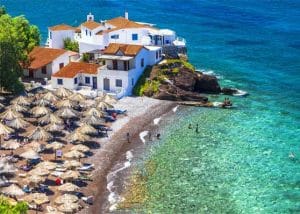
But there are also more classic beaches, accessible by boats and water taxis, which depart from the Clock, in the center of the port. The best beaches, which combine fine pebbles and pine trees, are Bisti and Agios Nikolaos: they have umbrellas and snack bars.
Closer to the port is the organized pebbly beach of Vlychos, connected to it by regular transport. Another alternative is to tour the island by sea.
Where to stay
Despite being a small island Hydra has a decent supply of holiday accommodation as the island is popular with weekending Greeks and because, in its shipbuilding heyday, many large houses were built to house wealthy traders and merchants.
Accommodation on Hydra is relatively expensive as Hydra appeals to wealthy Athenian weekenders and reservations are highly advisable in the summer season, especially at weekends.
Hardly surprising in a traffic-free island, most of the hotels and rooms are in the main port at Hydra Town, and most are within walking distance of the harbour. Beach and watersports enthusiasts will head to Mandraki, east of the town where the main hotel owns Hydra’s only decent sandy beach and offers water skiing, windsurfing, sailing and canoeing.
To the west of Hydra town there are rooms to let at the picturesque port of Kamini and at Vlychos where locals generally ignore casual camping.
How to get to Hydra
By Air
There is no airport on Hydra. The nearest airport is at Athens International (ATH) where travellers can find a helicopter service to Hydra island.
The helicopter flight takes about 20 minutes but in poor weather it is diverted to Porto Heli, on the Peloponnese mainland, where there are water taxis to Hydra.
Arriving in such style costs an arm and a leg so most will catch a ferry or fast hydrofoil from Piraeus.
Athens International Airport is located about 27km to the east of Athens and is officially called the Elefterios Venizelos Airport it handles about 11 million passenger a year.
The E96 airport shuttle bus leaves daily for the port at Piraeus. This is a 24 hr service and you can find the bus terminus outside the Arrivals hall.
The E96 leaves every 15 to 20 minutes during the day and every 30 minutes at night and the journey takes 45 to one hour depending on the traffic.
The taxi rank is located next to Door 3 outside the Arrivals hall. Taxi to Piraeus is are more expensive and journey times depend on traffic and can be anything from 30 to 50 minutes.
Getting there by the sea
Hydra lies between the Saronic Gulf and Argolis Gulf about 37 nautical miles from Piraeus. It’s a 90 minute crossing by hydrofoil and around three hours by conventional ferry.
The main fast ferry company sailing to Hydra is Hellenic Seaways which operates up to four Flying Dolphin services daily from Piraeus calling in a Poros, mainland Ermioni, Spetses and Porto Heli.
Flying Dolphins only take foot passengers so those travelling with heavy luggage will need to book the daily catamaran service run by Hellenic Seaways.
Several ferry firms used to include Hydra on it routes including Aegean Flying Dolphins, Euro Seas Lines and Nova Ferries but Hellenic appears to be the only company offering regular ferry services at the moment.
Water taxis line the jetty in the main port of Hydra and most owners have mobile phones so they can be contacted any time. There is no official tariff but owners have agreed set prices and there is a central phone 0298 53690 answered by the first boat owner available.
Most water buses can take up to 10 people and you can cut costs by teaming up with neighbours to take a boat at the same time.
Caiques also go to various beaches around the island. Boards on the jetty announce prices and times of sailing. Holidaymakers may have to wait until there are enough passengers enough for the captain to think it worth sailing. Caiques also go to offshore islets of Dokos, Kivotos, and Petasi.
